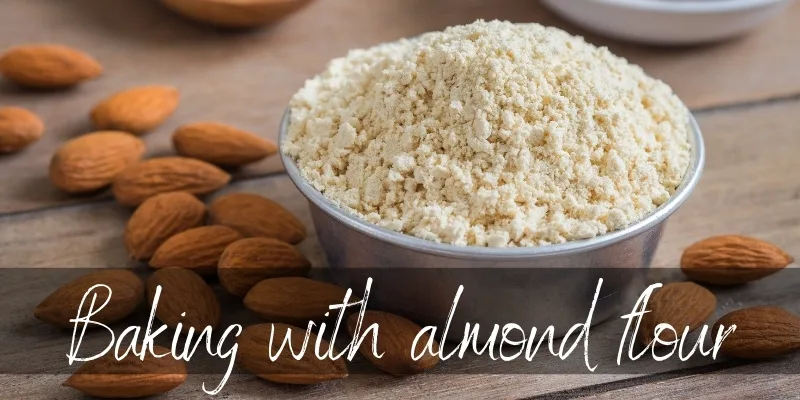If you’re on a gluten-free diet or simply want to try another flour, almond flour is the most common option. It’s gluten-free and fairly easy to get a hold of. Unless you’re doing large amounts of baking each day, almond flour doesn’t end up that expensive, given how little you need at a time.
So how do you substitute almond flour for all-purpose flour ? Can you use it 1:1 ? Does it need anything special to rise ? Or is it just like all-purpose flour ? Let’s take a look.

Can you substitute almond flour for all-purpose flour?
Almond flour can be substituted for all-purpose flour 1:1, and it will need an extra binding agent. Because almonds don’t contain gluten, almond flour-based dough and batters don’t stick as well and they can crumble very easily.
There is a little more moisture in almond flour than regular flour so keep that in mind and later the recipe a little.
Be careful when buying almond flour. There’s almond flour, and there’s almond meal. Almond meal is ground almonds that have been used to make almond milk and then left to dry. You use those for macarons, mostly. They’re about the size of cornmeal.
Almond flour is made of blanched almonds that have the skins removed. It’s finely ground almonds, finer than almond meal. That being said, you can sometimes find almond flour labeled as almond meal.
If you somehow happen to buy meal instead of flour, you have the option of either a burr grinder or a mortar and pestle to grind it down further. You can still bake with almond meal, but it will be coarser.
Read also: Sweet Rice Flour Substitutes (Gluten Free)
How does almond flour affect baking ?
Almond flour has no gluten, which means it will not bind as well as other flours. This means some baked goods may spread more or become more crumbly, like cookies and shortbread.
There are a few more things almond flour changes when you incorporate it into a baking recipe. Let’s take a look.
Be sure to add more binding agent
As mentioned before, almond flour doesn’t stick as much, so you will need more eggs. You can swap the eggs for ground flax seeds and water, or aquafaba, applesauce.
Depending on your recipe, this may also mean adjusting the cooking time. If you’re making a sauce and simply want to thicken, then adding cornstarch (gluten-free) will help a lot.
Almond flour is moister
Almond flour, compared to wheat flour, is a little moister. This means that when you’re mixing, you should check for clumps more thoroughly, and your baked goods may not dry out completely. This could also affect how quickly mold develops.
You can try offsetting this by adding less moist ingredients like milk or water or fruit juice.
Baked goods may burn faster
If you try to offset the extra moisture by longer bake times, you may end up with burnt cookies or cakes. Only try this in small batches, on a low heat setting. The main reason behind this is almond flour’s low carb and high fat content.
Conversely, you may also notice that almond flour bakes don’t rise as much as wheat flour bakes. This is because the almonds a grittier than ground wheat, so they end up a little heavier in the batter or dough. They will rise, but if you’re looking for extra fluffy cakes you may need lots of egg whites or some baking soda.
Almond flour adds more texture
Because almond flour is not very fine and smooth, you’ll notice more texture in your baked goods or sauces than wheat flour. This can be a good or bad thing, depending on your preferences. In cakes and breaks, more texture can be great if you’re going for a rusting tone or simply like the idea of a textured cake.
If you’re looking for something smooth and fine, then almond flour can’t really offer you that, because it’s not as finely ground as other flour types. A fine, gluten-free flour that can give you a smooth cake is rice flour.
Can you bake with almond milk ?
You may be wondering if you can bake with almond milk, as an all-almond recipe or maybe you can’t have dairy milk. In short, yes, you can bake with almond milk, the only problem is the lower fat content compared to full fat dairy milk.

It’s more of a 2% milk, and the taste will be more watery than dairy milk. This means it may be easier to digest for some folks, and may not trigger some allergic reactions in others. You can use it 1:1 in place of regular milk.
If you want a creamier, smoother milk then go for cashew or soy milk.
Read Also: Best Gram Flour Substitutes
Does almond flour taste like flour ?
No, almond flour tastes like almonds, but in a milder way. Flour has its flavor from wheat, ground wheat. Almond flour has no wheat in it, so it will only taste of almond, and a little nutty. That being said, you may notice the almond flavor in baked goods, but it won’t be overwhelming.
It is not a neutral flour, like wheat flour. If you’re looking for a neutral flour that is also gluten-free, go for rice flour.
Conclusion
The conclusion is that you can substitute almond flour for all-purpose flour but there are a few extra steps to do it properly. If you simply substitute them without adding a binding agent you will be disappointed with the result you get because it most likely will not stick as well.
I hope this article helped you to know if you need to substitute them in your specific situation and what to expect from your recipe.

